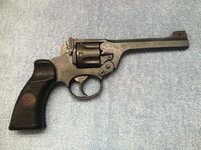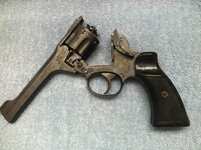

 1943 date stamp on barrel, all serial numbers match, tanker version grips, bobbed hammer for DA only, 38 s & w chambered. $450 cash. Trade preferred. Trade for about anything firearms related. I lean towards broken, ugly, rusty. I do some minor repairs, stock refinish, cerakote and blue, so finish not an issue. Over and under 12 guage or handguns get preference. I'm a WAC member located N of Everett, can travel on weekends
1943 date stamp on barrel, all serial numbers match, tanker version grips, bobbed hammer for DA only, 38 s & w chambered. $450 cash. Trade preferred. Trade for about anything firearms related. I lean towards broken, ugly, rusty. I do some minor repairs, stock refinish, cerakote and blue, so finish not an issue. Over and under 12 guage or handguns get preference. I'm a WAC member located N of Everett, can travel on weekends










